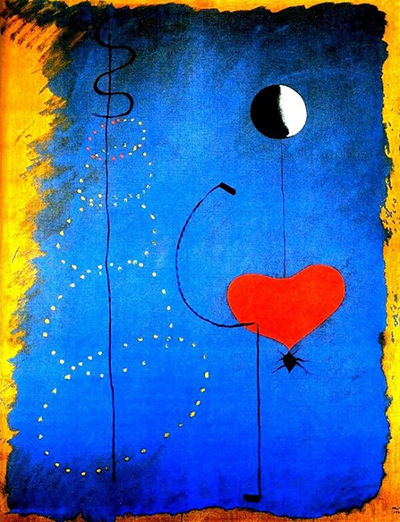Miro's productive year of 1925 brought about a number of important artworks within his career, one of which was titled Dancer. It is displayed here.
The content found in this painting immediately strikes us as surrealist - there are recognisable objects, but their arrangement is bizarre. One could be within a dream as we view this painting, and that feeling is entirely in line with this popular art movement from the 20th century. Miro did not actually recognise himself as a surrealist, but his similarity was undeniable. He was a true abstract artist who declared war on the traditional art forms, and so he would always have plenty in common with the Surrealist group, even if he avoided the label for his own work. We see, initially, a heart hanging from a moon by a single thread. There seems to be a spider that himself hangs from the heart. To the left there are further dark lines but the overall scene is dominated by the blue tones which cover most of the background. There are also circles of yellow dots which lead upwards towards a snake-like curve in black.
Miro worked aggressively to put the earlier elements of the painting together. One can immediately see the individual strokes that he made to create the tones of blue on which the main content is added. We can also see the original background prime of brown which shows through in some areas of the artwork. Movement feels significant to the left hand side of the work, but on the right there is an atmosphere of stillness, albeit precariously. Prior to modern art, one cannot imagine a canvas so littered with inprecision, almost randomness, but this was entirely the intention of an artist who was perfectly capable of producing traditional art, but simply wanted something more expressive, ultimately more from his own heart, with inspirations from the deepest parts of his mind.
We mentioned earlier about how perhaps a moon and spider can be found on the left - well that was our first reading. Actually, this is a surrealist depiction of a woman, the dancer mentioned in the title, and once we become aware of that we can then be more accurate in our description of the meaning of each item in front of us. The circle is actually her head, with the black mark below the heart being her own genitals. The two narrow lines then become her legs and finally we can now understand what exactly we are viewing! It is believed that a visit to a show in Spain had inspired this particular piece.




